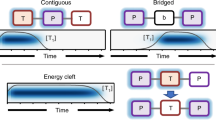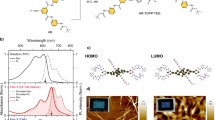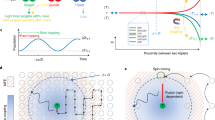Abstract
The ability to advance our understanding of multiple exciton generation (MEG) in organic materials has been restricted by the limited number of materials capable of singlet fission. A particular challenge is the development of materials that undergo efficient intramolecular fission, such that local order and strong nearest-neighbour coupling is no longer a design constraint. Here we address these challenges by demonstrating that strong intrachain donor–acceptor interactions are a key design feature for organic materials capable of intramolecular singlet fission. By conjugating strong-acceptor and strong-donor building blocks, small molecules and polymers with charge-transfer states that mediate population transfer between singlet excitons and triplet excitons are synthesized. Using transient optical techniques, we show that triplet populations can be generated with yields up to 170%. These guidelines are widely applicable to similar families of polymers and small molecules, and can lead to the development of new fission-capable materials with tunable electronic structure, as well as a deeper fundamental understanding of MEG.
This is a preview of subscription content, access via your institution
Access options
Subscribe to this journal
Receive 12 print issues and online access
$259.00 per year
only $21.58 per issue
Buy this article
- Purchase on Springer Link
- Instant access to full article PDF
Prices may be subject to local taxes which are calculated during checkout





Similar content being viewed by others
References
Yu, G., Gao, J., Hummelen, J. C., Wudl, F. & Heeger, A. J. Polymer photovoltaic cells: Enhanced efficiencies via a network of internal donor–acceptor heterojunctions. Science 270, 1789–1791 (1995).
Tang, C. W. Two-layer organic photovoltaic cell. Appl. Phys. Lett. 48, 183–185 (1986).
Gélinas, S. et al. Ultrafast long-range charge separation in organic semiconductor photovoltaic diodes. Science 343, 512–516 (2014).
Brédas, J-L., Norton, J. E., Cornil, J. & Coropceanu, V. Molecular understanding of organic solar cells: The challenges. Acc. Chem. Res. 42, 1691–1699 (2009).
Erb, T. et al. Correlation between structural and optical properties of composite polymer/fullerene films for organic solar cells. Adv. Funct. Mater. 15, 1193–1196 (2005).
Kim, J. Y. et al. Efficient tandem polymer solar cells fabricated by all-solution processing. Science 317, 222–225 (2007).
You, J. et al. A polymer tandem solar cell with 10.6% power conversion efficiency. Nature Commun. 4, 1446 (2013).
Small, C. E. et al. High-efficiency inverted dithienogermole-thienopyrrolodione-based polymer solar cells. Nature Photon. 6, 115–120 (2012).
Sun, Y. et al. Solution-processed small-molecule solar cells with 6.7% efficiency. Nature Mater. 11, 44–48 (2012).
Shockley, W. & Queisser, H. J. Detailed balance limit of efficiency of p–n junction solar cells. J. Appl. Phys. 32, 510–519 (1961).
Hanna, M. C. & Nozik, A. J. Solar conversion efficiency of photovoltaic and photoelectrolysis cells with carrier multiplication absorbers. J. Appl. Phys. 100, 074510 (2006).
Ehrler, B. et al. In situ measurement of exciton energy in hybrid singlet-fission solar cells. Nature Commun. 3, 1019 (2012).
Tritsch, J. R., Chan, W-L., Wu, X., Monahan, N. R. & Zhu, X. Y. Harvesting singlet fission for solar energy conversion via triplet energy transfer. Nature Commun. 4, 2679 (2013).
Congreve, D. N. et al. External quantum efficiency above 100% in a singlet-exciton-fission–based organic photovoltaic cell. Science 340, 334–337 (2013).
Johnson, J. C., Nozik, A. J. & Michl, J. The role of chromophore coupling in singlet fission. Acc. Chem. Res. 46, 1290–1299 (2013).
Smith, M. B. & Michl, J. Singlet fission. Chem. Rev. 110, 6891–6936 (2010).
Roberts, S. T. et al. Efficient singlet fission discovered in a disordered acene film. J. Am. Chem. Soc. 134, 6388–6400 (2012).
Yost, S. R. et al. A transferable model for singlet fission kinetics. Nature Chem. 6, 492–497 (2014).
Antognazza, M. R. et al. Ultrafast excited state relaxation in long-chain polyenes. Chem. Phys. 373, 115–121 (2010).
Kraabel, B., Hulin, D., Aslangul, C., Lapersonne-Meyer, C. & Schott, M. Triplet exciton generation, transport and relaxation in isolated polydiacetylene chains: Subpicosecond pump-probe experiments. Chem. Phys. 227, 83–98 (1998).
Musser, A. J. et al. Activated singlet exciton fission in a semiconducting polymer. J. Am. Chem. Soc. 135, 12747–12754 (2013).
Gradinaru, C. C. et al. An unusual pathway of excitation energy deactivation in carotenoids: Singlet-to-triplet conversion on an ultrafast timescale in a photosynthetic antenna. Proc. Natl Acad. Sci. USA 98, 2364–2369 (2001).
Papagiannakis, E. et al. Light harvesting by carotenoids incorporated into the B850 light-harvesting complex from rhodobacter sphaeroides R-26.1: Excited-state relaxation, ultrafast triplet formation, and energy transfer to bacteriochlorophyll. J. Phys. Chem. B 107, 5642–5649 (2003).
Johnson, J. C. et al. Toward designed singlet fission: Solution photophysics of two indirectly coupled covalent dimers of 1,3-diphenylisobenzofuran. J. Phys. Chem. B 117, 4680–4695 (2013).
Dell, E. J. & Campos, L. M. The preparation of thiophene-S, S-dioxides and their role in organic electronics. J. Mater. Chem. 22, 12945–12952 (2012).
Wei, S. et al. Bandgap engineering through controlled oxidation of polythiophenes. Angew. Chem. Int. Ed. 53, 1832–1836 (2014).
Beljonne, D., Yamagata, H., Brédas, J., Spano, F. & Olivier, Y. Charge-transfer excitations steer the Davydov splitting and mediate singlet exciton fission in pentacene. Phys. Rev. Lett. 110, 226402 (2013).
Berkelbach, T. C., Hybertsen, M. S. & Reichman, D. R. Microscopic theory of singlet exciton fission. I. General formulation. J. Chem. Phys. 138, 114102 (2013).
Berkelbach, T. C., Hybertsen, M. S. & Reichman, D. R. Microscopic theory of singlet exciton fission II. Application to pentacene dimers and the role of superexchange. J. Chem. Phys. 138, 114103 (2013).
Chan, W-L. et al. The quantum coherent mechanism for singlet fission: Experiment and theory. Acc. Chem. Res. 46, 1321–1329 (2013).
Chan, W-L. et al. Observing the multiexciton state in singlet fission and ensuing ultrafast multielectron transfer. Science 334, 1541–1545 (2011).
Chan, W-L., Ligges, M. & Zhu, X. Y. The energy barrier in singlet fission can be overcome through coherent coupling and entropic gain. Nature Chem. 4, 840–845 (2012).
Sharifzadeh, S., Darancet, P., Kronik, L. & Neaton, J. B. Low-energy charge-transfer excitons in organic solids from first-principles: The case of pentacene. J. Phys. Chem. Lett. 4, 2197–2201 (2013).
Zhou, H., Yang, L. & You, W. Rational design of high performance conjugated polymers for organic solar cells. Macromolecules 45, 607–632 (2012).
Kitamura, C., Tanaka, S. & Yamashita, Y. Design of narrow-bandgap polymers. Syntheses and properties of monomers and polymers containing aromatic-donor and o-quinoid-acceptor units. Chem. Mater. 8, 570–578 (1996).
Brédas, J. Relationship between band gap and bond length alternation in organic conjugated polymers. J. Chem. Phys. 82, 3808–3811 (1985).
Havinga, E., Ten Hoeve, W. & Wynberg, H. A new class of small band gap organic polymer conductors. Polym. Bull. 29, 119–126 (1992).
Szarko, J. M. et al. Electronic processes in conjugated diblock oligomers mimicking low band-gap polymers. Experimental and theoretical spectral analysis. J. Phys. Chem. B 114, 14505–14513 (2010).
Guo, J., Ohkita, H., Benten, H. & Ito, S. Near-IR femtosecond transient absorption spectroscopy of ultrafast polaron and triplet exciton formation in polythiophene films with different regioregularities. J. Am. Chem. Soc. 131, 16869–16880 (2009).
Mullen, K. M., Vengris, M. & van Stokkum, I. H. Algorithms for separable nonlinear least squares with application to modelling time-resolved spectra. J. Glob. Optim. 38, 201–213 (2007).
Van Stokkum, I. H., Larsen, D. S. & van Grondelle, R. Global and target analysis of time-resolved spectra. Biochim. Biophys. Acta 1657, 82–104 (2004).
Wishart, J. F., Cook, A. R. & Miller, J. R. The LEAF Picosecond Pulse Radiolysis Facility at Brookhaven National Laboratory. Rev. Sci. Instrum. 75, 4359–4366 (2004).
Head-Gordon, M., Grana, A. M., Maurice, D. & White, C. A. Analysis of electronic transitions as the difference of electron attachment and detachment densities. J. Phys. Chem. 99, 14261–14270 (1995).
Oliva, M. M. et al. Do [all]-S, S′-dioxide oligothiophenes show electronic and optical properties of oligoenes and/or of oligothiophenes? J. Am. Chem. Soc. 132, 6231–6242 (2010).
Amir, E. et al. Synthesis and characterization of soluble low-bandgap oligothiophene-[all]-S, S-dioxides-based conjugated oligomers and polymers. J. Polym. Sci. A 49, 1933–1941 (2011).
Sreearunothai, P. et al. Triplet transport to and trapping by acceptor end groups on conjugated polyfluorene chains. J. Phys. Chem. C 115, 19569–19577 (2011).
Heinzelmann, W. & Labhart, H. Triplet–triplet spectra and triplet quantum yields of some aromatic hydrocarbons in liquid solution. Chem. Phys. Lett. 4, 20–24 (1969).
Acknowledgements
This project was funded through the Center for Re-Defining Photovoltaic Efficiency Through Molecular-Scale Control, an Energy Frontier Research Center funded by the US Department of Energy (DOE), Office of Science, Office of Basic Energy Sciences under Award DE-SC0001085. L.M.C. thanks 3M Non-Tenured Faculty Award and the NSF CAREER (DMR-1351293) for funding the synthesis of the small molecules and control materials. X-Y.Z. acknowledges support by the National Science Foundation, DMR-1321405. We wish to thank M. Vengris (Vilnius University) for graciously providing his global analysis software package for our use. We also thank S. Wei for a sample of PFTDO1 and J. Hoy for additional cyclic voltammetry measurements. Research was carried out in part at the Center for Functional Nanomaterials, Brookhaven National Laboratory, which is supported by the US Department of Energy, Office of Basic Energy Sciences, under Contract No. DE-AC02-98CH10886, and in the Chemistry Department, Brookhaven National Laboratory through Grant #DE-AC02-98-CH10886, which also supports the LEAF Facility of the BNL Accelerator Center for Energy Research.
Author information
Authors and Affiliations
Contributions
E.B., J.X., L.M.C. and M.Y.S. conceived the experiments. L.M.C. and M.Y.S. supervised the project. J.X., J.Z.L. and R.S. synthesized and characterized the materials. E.B. performed transient absorption data acquisition and analysis. Q.W. provided theoretical support. J.R.M. and E.B. performed pulse radiolysis experiments. E.B., L.M.C. and M.Y.S. wrote the manuscript with input from all authors.
Corresponding authors
Ethics declarations
Competing interests
The authors declare no competing financial interests.
Supplementary information
Supplementary Information
Supplementary Information (PDF 3821 kb)
Rights and permissions
About this article
Cite this article
Busby, E., Xia, J., Wu, Q. et al. A design strategy for intramolecular singlet fission mediated by charge-transfer states in donor–acceptor organic materials. Nature Mater 14, 426–433 (2015). https://doi.org/10.1038/nmat4175
Received:
Accepted:
Published:
Issue Date:
DOI: https://doi.org/10.1038/nmat4175
This article is cited by
-
A single n-type semiconducting polymer-based photo-electrochemical transistor
Nature Communications (2023)
-
Quantum interference effects elucidate triplet-pair formation dynamics in intramolecular singlet-fission molecules
Nature Chemistry (2023)
-
Promoting multiexciton interactions in singlet fission and triplet fusion upconversion dendrimers
Nature Communications (2023)
-
Orbital-resolved observation of singlet fission
Nature (2023)
-
Singlet fission dynamics modulated by molecular configuration in covalently linked pyrene dimers, Anti- and Syn-1,2-di(pyrenyl)benzene
Communications Chemistry (2023)



